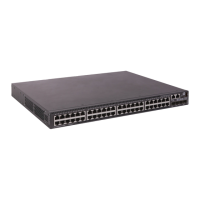40
Ste
Command
Remarks
4. Configure the
SNMP access
right.
• (Method 1.) Create an SNMP community and specify ACLs
for the community:
{ In VACM mode:
snmp-agent community { read | write } [ simple |
cipher ] community-name [ mib-view view-name ] [ acl
acl-number | acl ipv6 ipv6-acl-number ] *
{ In RBAC mode:
snmp-agent community [ simple | cipher ]
community-name user-role role-name [ acl acl-number |
acl ipv6 ipv6-acl-number ] *
• (Method 2.) Create an SNMPv1/v2c group and add a user
to the group, specifying ACLs for the group and user:
a. snmp-agent group { v1 | v2c } group-name
[ read-view view-name ] [ write-view view-name ]
[ notify-view view-name ] [ acl acl-number | acl ipv6
ipv6-acl-number ] *
b. snmp-agent usm-user { v1 | v2c } user-name
group-name [ acl acl-number | acl ipv6
ipv6-acl-number ] *
For more
information about
SNMP, see
Network
Management and
Monitoring
Configuration
Guide.
To control SNMPv3 access, configure ACLs and complete the following configuration:
Ste
Command
Remarks
5. Enter system
view.
system-view N/A
6. Create an
SNMPv3 group,
specifying ACLs
for the group.
snmp-agent group v3 group-name [ authentication | privacy ]
[ read-view view-name ] [ write-view view-name ] [ notify-view
view-name ] [ acl acl-number | acl ipv6 ipv6-acl-number ] *
N/A
7. Create an
SNMPv3 user,
specifying ACLs
for the user.
• In VACM mode:
snmp-agent usm-user v3 user-name group-name [ remote
{ ip-address | ipv6 ipv6-address } ] [ { cipher | simple }
authentication-mode { md5 | sha } auth-password
[ privacy-mode { aes128 | 3des | des56 } priv-password ] ]
[ acl acl-number | acl ipv6 ipv6-acl-number ] *
• In RBAC mode:
snmp-agent usm-user v3 user-name user-role role-name
[ remote { ip-address | ipv6 ipv6-address } ] [ { cipher |
simple } authentication-mode { md5 | sha } auth-password
[ privacy-mode { aes128 | 3des | des56 } priv-password ] ]
[ acl acl-number | acl ipv6 ipv6-acl-number ] *
For more
information about
SNMP, see
Network
Management and
Monitoring
Configuration
Guide.
Configuration example
Network requirements
As shown in Figure 21, the device is running SNMP.
Configure the device to allow Host A and Host B to access the device through SNMP.

